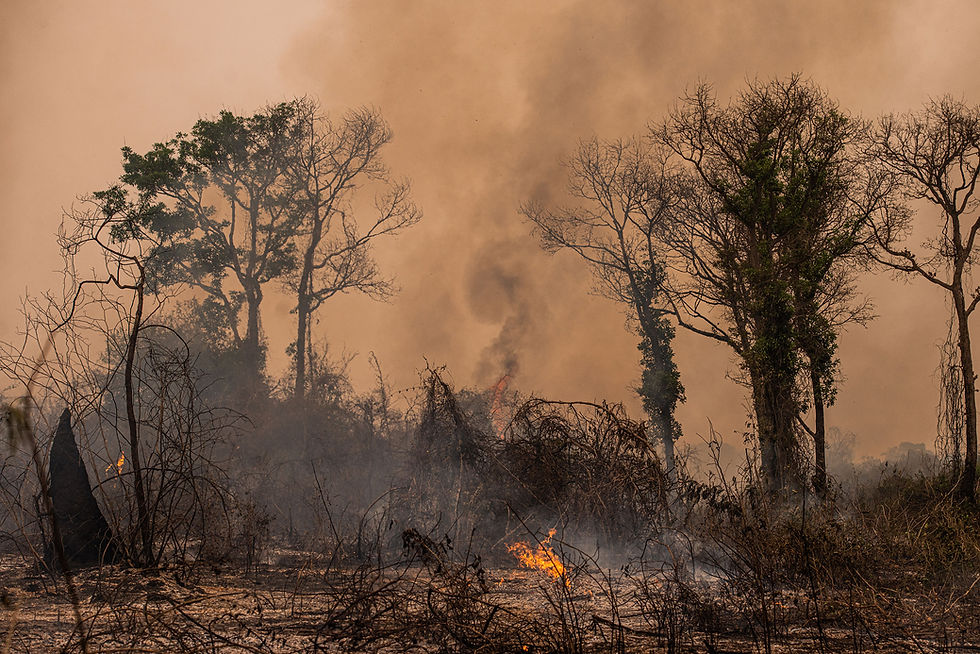Wildfires & Climate Change: Lethal Cycle
- Sylvia Rose

- Mar 28
- 4 min read
Wildfires rage through forest, savannah and even urban regions. Frequency and intensity of wildfires increase dramatically as they're fed by climate change, and their heat and emissions in turn worsen its effects.

Wildfires happen almost anywhere. They can be caused by factors like careless campfires and lightning strikes. Climate change is increasingly identified as a primary factor behind the current wildfire crisis.
Wildfires are a natural part of many ecosystems, but those today are different. They're more frequent, more intense, and cover larger areas, leaving scorched earth and devastation.
Rising global temperatures, extended droughts, and shifting precipitation patterns elevate the risk of wildfires. When environments become dryer, the vegetation that usually retains moisture turns into fuel, making it easier for wildfires to start.

For example, in California, the average annual temperature has risen since the 1970s, contributing to a higher risk of wildfires during heatwaves. The 2025 wildfires in Los Angeles are proof of the escalating crisis.
A series of fires in Southern California, specifically in the Greater Los Angeles area, causes at least 29 deaths, thousands of destroyed structures, evacuations and widespread power outages in January 2025.
Regions accustomed to manageable burns now battle unprecedented infernos. Wildfire intensity threatens communities, destroys habitats and release massive amounts of carbon dioxide into the atmosphere.
CO2 further exacerbates the problem. The cycle is driven by the aggressive relationship between climate change and environmental conditions conducive to wildfire eruption and spread.

Many regions throughout the world experience increased occurrences of severe droughts, heatwaves, and intense storms. Extreme heat causes suffering and death in countries from the US to Asia.
Heat-related weather affects vegetation, causing a drop in moisture. Dryness makes it easier for fires to spread.
In regions like the western United States, wildfires are frequent, with a 300% increase in area burned between 1980 and 2020. In 2025, a March 1 release from the National Interagency Fire Center reads:
"Fifteen new large wildfires were reported yesterday in the Southern, Rocky Mountain, and Eastern areas. Fifty large uncontained fires are burning in 16 states, 23 are burning in Oklahoma. Nearly 2,100 wildland firefighters and support personnel are assigned to incidents across the nation.
Since January 1, 11,912 wildfires have burned 396,631 acres across the United States. This is above the 10-year average of 7,157 wildfires and below the 10-year average acreage of 541,795."

As global temperatures rise, so does the energy in the atmosphere. A warmer atmosphere holds more moisture, leading to more powerful thunderstorms and, consequently, more lightning.
As lightning is a major natural cause of wildfire ignition, a surge in lightning strikes creates greater risk of wildfires. A study from U of California reports a 25% increase in lightning strikes in some areas due to climate change.
The fuel for megafires comes from the drying effects of climate change. Severe heatwaves contribute to widespread and prolonged droughts. The 2023 wildfire crisis in Canada follows periods of intense dryness or drought.
In Australia the climate warms by more than one degree Celsius over the past century. This small rise is enough to increase the frequency and intensity of heatwaves and droughts.
Eight of Australia's ten hottest years on record have occurred since 2005. Major droughts of the late 20th century and early 21st century in southern Australia are considered without precedent in the past 400 years.

Bushfires engulf the lands. Until the 2019–2020 Australian bushfire season, forests in Australia are thought to reabsorb all the carbon released in bushfires across the country.
The 2019–2020 bushfires emit 400 megatonnes of carbon dioxide into the atmosphere, more than all Australia's emissions for three months.
2019 is Australia's driest year since 1900 with rainfall 40% below average.
Handling fires can be limited by funding and equipment. The Forest Survey of India (FSI) sends daily satellite forest fire data to all states. It reports seven major fires in Jharkhand on March 24 2025.
Five are in West Singhbhum district, and one each in Khunti and Pakur. Forest frontline ground crew have only fire blowers, beaters and fire rakes to fight the blazes.

Today in South Korea, the largest wildfires in its history rip through the land during an especially dry period. At least 27 people have died, most of them elderly, in the race to escape the fast-moving flames.
Beyond the immediate destruction of homes and infrastructure, prolonged exposure to smoke from fires is a public health threat. Respiratory issues are dangerous for everyone, especially those with pre-existing conditions.
Smoke and fires also disrupt ecosystems, displace and kill wildlife, and destroy habitats. Long-term consequences, including soil erosion and water contamination can persist for decades.
Wildfires contribute to the climate change that fuels them with a growing feedback loop. As forests burn, they release stored carbon back into the atmosphere, accelerating global warming to increase risk of more wildfires.

READ: Lora Ley Adventures - Germanic Mythology Fiction Series
READ: Reiker For Hire - Victorian Detective Murder Mysteries


